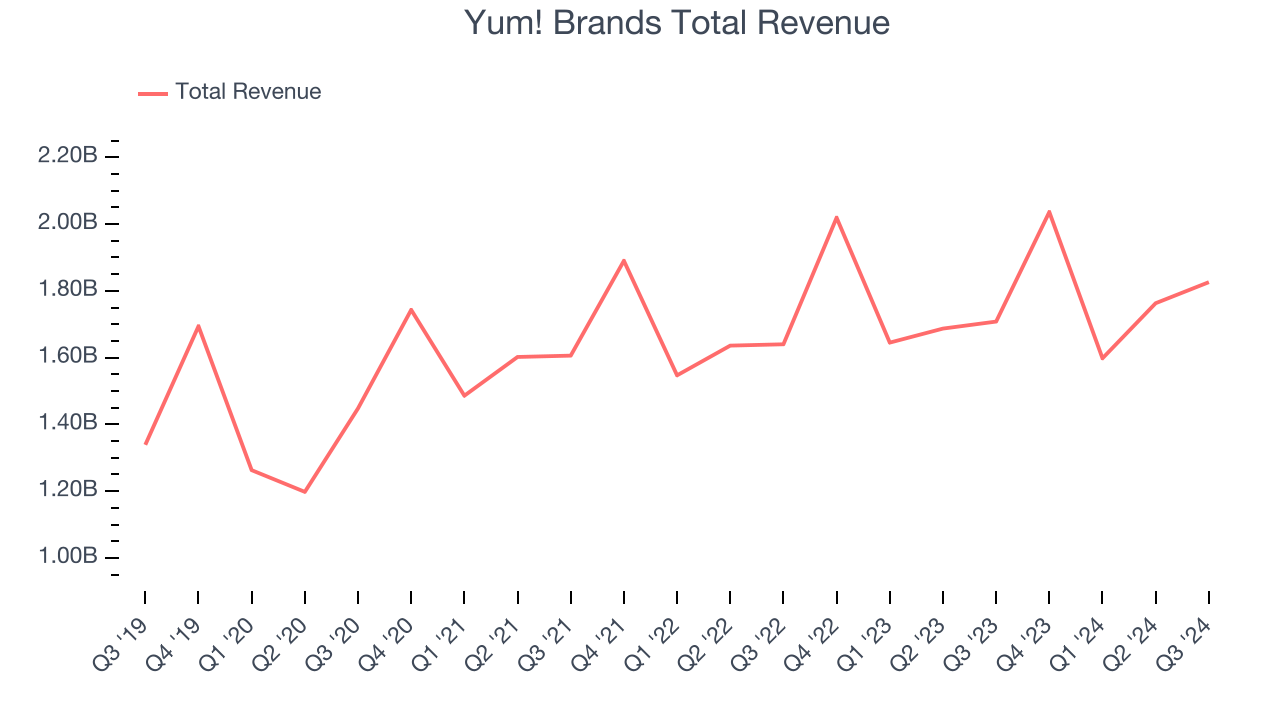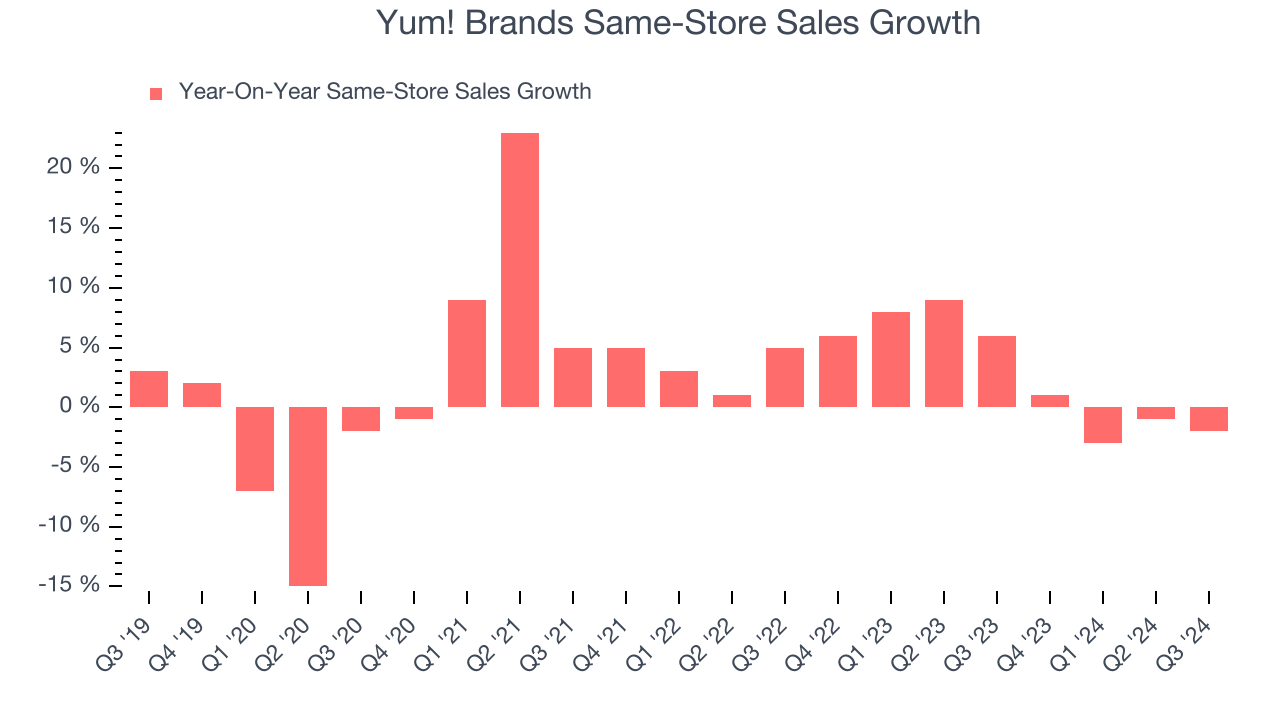
Fast-food company Yum! Brands (NYSE:YUM) fell short of the market’s revenue expectations in Q3 CY2024, but sales rose 6.9% year on year to $1.83 billion. Its non-GAAP profit of $1.37 per share was also 2.8% below analysts’ consensus estimates.
Is now the time to buy Yum! Brands? Find out by accessing our full research report, it’s free.
Yum! Brands (YUM) Q3 CY2024 Highlights:
- Revenue: $1.83 billion vs analyst estimates of $1.89 billion (3.6% miss)
- Adjusted EPS: $1.37 vs analyst expectations of $1.41 (2.8% miss)
- EBITDA: $715 million vs analyst estimates of $680.1 million (5.1% beat)
- Gross Margin (GAAP): 47.4%, down from 50.3% in the same quarter last year
- Operating Margin: 33.9%, down from 35.9% in the same quarter last year
- EBITDA Margin: 39.2%, up from 38.1% in the same quarter last year
- Free Cash Flow Margin: 22.9%, down from 24.6% in the same quarter last year
- Locations: 59,664 at quarter end, up from 57,274 in the same quarter last year
- Same-Store Sales fell 2% year on year (6% in the same quarter last year) (Taco Bell same-store sales beat expectations, KFC and Pizza Hut missed)
- Market Capitalization: $37.33 billion
Company Overview
Spun off as an independent company from PepsiCo, Yum! Brands (NYSE:YUM) is a multinational corporation that owns KFC, Pizza Hut, Taco Bell, and The Habit Burger Grill.
Traditional Fast Food
Traditional fast-food restaurants are renowned for their speed and convenience, boasting menus filled with familiar and budget-friendly items. Their reputations for on-the-go consumption make them favored destinations for individuals and families needing a quick meal. This class of restaurants, however, is fighting the perception that their meals are unhealthy and made with inferior ingredients, a battle that's especially relevant today given the consumers increasing focus on health and wellness.
Sales Growth
Examining a company’s long-term performance can provide clues about its business quality. Any business can put up a good quarter or two, but the best consistently grow over the long haul.
Yum! Brands is larger than most restaurant chains and benefits from economies of scale, enabling it to gain more leverage on fixed costs than its smaller competitors. However, its scale is a double-edged sword because it's harder to find incremental growth when you've already penetrated the market.
As you can see below, Yum! Brands’s 5.8% annualized revenue growth over the last five years (we compare to 2019 to normalize for COVID-19 impacts) was tepid, but to its credit, it opened new restaurants and increased sales at existing, established dining locations.

This quarter, Yum! Brands’s revenue grew 6.9% year on year to $1.83 billion, missing Wall Street’s estimates.
Looking ahead, sell-side analysts expect revenue to grow 13% over the next 12 months, an acceleration versus the last five years. This projection is commendable and shows the market thinks its newer offerings will fuel higher growth rates.
Unless you’ve been living under a rock, it should be obvious by now that generative AI is going to have a huge impact on how large corporations do business. While Nvidia and AMD are trading close to all-time highs, we prefer a lesser-known (but still profitable) semiconductor stock benefitting from the rise of AI. Click here to access our free report on our favorite semiconductor growth story.
Restaurant Performance
Number of Restaurants
A restaurant chain’s total number of dining locations often determines how much revenue it can generate.
Yum! Brands operated 59,664 locations in the latest quarter. It has opened new restaurants at a rapid clip over the last two years and averaged 5% annual growth, much faster than the broader restaurant sector. Furthermore, one dynamic making expansion more seamless is the company’s franchise model, where franchisees are primarily responsible for opening new restaurants while Yum! Brands provides support.
When a chain opens new restaurants, it usually means it’s investing for growth because there’s healthy demand for its meals and there are markets where the concept has few or no locations.

Same-Store Sales
A company's restaurant base only paints one part of the picture. When demand is high, it makes sense to open more. But when demand is low, it’s prudent to close some locations and use the money in other ways. Same-store sales gives us insight into this topic because it measures organic growth for restaurants open for at least a year.
Yum! Brands’s demand has been healthy for a restaurant chain over the last two years. On average, the company has grown its same-store sales by a robust 3% per year. This performance suggests its rollout of new restaurants could be beneficial for shareholders. When a chain has demand, more locations should help it reach more customers and boost revenue growth.

In the latest quarter, Yum! Brands’s same-store sales fell by 2% annually. This decline was a reversal from the 6% year-on-year increase it posted 12 months ago. We’ll keep a close eye on the company to see if this turns into a longer-term trend.
Key Takeaways from Yum! Brands’s Q3 Results
Yum! Brands's revenue missed analysts’ expectations, as a same-sales beat at Taco Bell but missed at KFC and Pizza Hut. The company couldn't make it up on the expense line, and EPS missed as well. Overall, this quarter could have been better. The stock traded down 1.1% to $131.25 immediately after reporting.
Yum! Brands didn’t show it’s best hand this quarter, but does that create an opportunity to buy the stock right now? When making that decision, it’s important to consider its valuation, business qualities, as well as what has happened in the latest quarter. We cover that in our actionable full research report which you can read here, it’s free.













